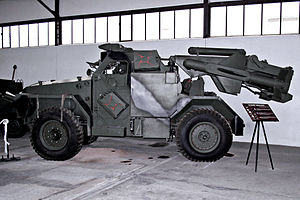Hornet Malkara
| Hornet Malkara | |
|---|---|

Malkara Humber Hornet at the Bovington Tank Museum |
|
| General properties | |
| crew | 3 men |
| length | 5 m |
| width | 2.22 m |
| height | 2.34 m |
| Dimensions | 5700 kg |
| Armor and armament | |
| Armor | 8-16 mm |
| Main armament | 2 × Malkara rocket launchers |
| Secondary armament | no |
| agility | |
| drive | 6-cylinder petrol engine Rolls-Royce B60 Mk5A 89 kW (120 PS) |
| suspension | Rigid axle |
| Top speed | 64 km / h (road) |
| Power / weight | 21.5 hp / t |
| Range | 400 km |
The Hornet Malkara is a British protected anti-tank vehicle developed in the 1950s .
history
The first missile-based anti-tank weapons appeared during World War II . The German Panzerfaust and the Panzerschreck were successfully used, as was the American Bazooka . The principle of using a missile for anti-tank defense promised success if only because the shooter is a relatively small target. With the development of longer range missiles, this concept was refined. Wire steering was developed for targeted shooting. In the 1950s, the British constructed the Hornet Malkara. The Malkara was built in such a way that it could be air-transported. In itself, the entire vehicle was immature, but it remained in service with the British Army until the 1970s. Despite the various problems the vehicle had, it paved the way for the development of advanced anti-tank vehicles and anti-tank weapons, such as the German Jaguar 1 tank destroyer, the TOW anti-tank guided missile and the international MILAN .
technology
With the end of the Second World War, the development of modern anti-tank weapons had taken a big step forward. Ever stronger armor required ever larger caliber anti-tank weapons, such as that of the Soviet 100 mm anti-tank gun and that of the German 12.8 cm PaK . Soviet main battle tanks such as the IS-2 had a 122mm cannon. All these weapons had in common that they were very large, heavy and not easy to use. Air loadability and buoyancy were not given. In addition, an increasing number of operating personnel always had to be available (at least for the cannons). The British tried to solve this problem with the Hornet Malkara.
The Hornet Malkara is based on the chassis of a Humber Pig 4 × 4 off-road vehicle. The chassis and passenger compartment were armored. The missiles were mounted on a launch frame at the stern.
To fire the rockets, the launcher was simply lifted above the driver's cab. The shooter fired the missiles from a maximum target distance of 2000 meters. Control was via a wire that was unwound from a spool. The goal had to remain visible. Night vision equipment was not provided. The missile's warhead was capable of destroying any tank of the time. The weight of the warhead was 27 kg.
As with most 4 × 4 wheeled vehicles, the cross-country ability of the Hornet Malkara is severely limited. Wading and deep driving skills are not available.
commitment
The Hornet Malkara was only used by the British armed forces. In fire fighting, the relatively small vehicle proved to be very camouflaged and, due to the range of the Malkara missiles, very superior. The commander sat on the left, which is unusual for British vehicles, and operated the missiles with a joystick.
In the Hornet Malkara, two missiles were carried in the launch frame and two more in the vehicle interior. The disadvantage was that the loading process was quite tedious. The British Army specially converted some aircraft for this system that could accommodate the vehicles. It was dropped on six special parachutes.
Two light machine guns could be mounted on the armored doors for close-range and self-defense .
literature
- Philip Trewhitt: tanks. The most important combat vehicles in the world from World War I to the present day . Neuer Kaiserverlag, Klagenfurt 2005, ISBN 3-7043-3197-X , ( Worth knowing - Technology ).
Web links
- Image and Technical Data (English)
- Humber Pig and variants at Panzerbaer.de
